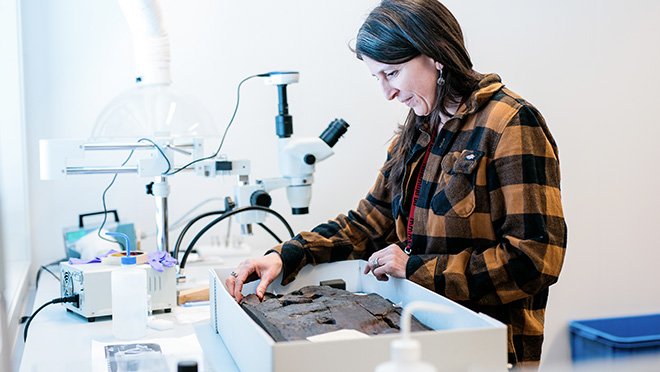The Gjellestad ship was first discovered using geophysics, which is a relatively new method in the archaeology field. The geo-radar is similar to a sonar that sends a signal down into the ground which reflects signals back. Based on these signals, archaeologists map areas that stand out from their surroundings - so-called anomalies. Archaeologists then interpret the results to assess whether or not there are archaeological structures below ground.
Preserved keel
During the 2019 trial excavation, the archaeologists found that the keel on the Gjellestad ship is still a whole piece of wood. We will bring all well-preserved wood into the museum for conservation and further documentation during the excavation. We hope to find more wood, and especially the larger ship parts that are deep in the soil. These may be constructions such as the keelson, if the ship had a mast, or the rudder, which is a large piece of wood that will protrude deeply in the ground. In addition, we hope that some of the strakes/planks is preserved, beyond just impressions in the soil.
The preserved timber in the ship is attacked by soft rot fungi and is therefore undergoing rapid decomposition. There are several factors causing the decomposition. The ground at Gjellestad consists of silts that conserves wood in the same way as the clay in which the Oseberg ship was found. Around 1880 the mound above the Gjellestad ship was removed in order to be able to farm more efficiently. When the protecting mound over the ship was removed, the degradation process escalated. Sometime after the war, a drainage ditch was dug through the ship. This caused a lowering of the groundwater level, which allowed oxygen to penetrate all the way down to the keel of the ship and aggravate the condition of the timber.
We are establishing a temporary conservation lab on site, with a large water tank we can put objects in. The further conservations in the museum's magazines will probably use a combination of freeze-drying the wood, and PEG / polyethylene glycol.
New methods in the field of archaeology
During the excavation and investigation, a number of new auxiliary sciences will be relevant to use:
Micromorphology
We may find traces of wooden objects that are only visible as imprints. One way to investigate such finds is to use micromorphology. We take samples of the soil layers, these are shipped to a lab and then impregnated in artificial resin, before being cut into a thin section that is studied under a microscope. In the microscope, you will be able to see details that are not visible to the naked eye, such as food residue.
aDNA
If we find bone fragments, we can study old DNA that is extracted from the biological material. The study of aDNA can provide information about human demographic history and relationships between different groups of people. The method is constantly evolving and there are still limitations associated with the analysis, and contamination with newer material is a known problem area. Nevertheless, DNA material will be able to tell us about who is buried in the Gjellestad ship. It will also be possible to do DNA tests on decomposed animal bone that may have been sacrificed in the ship, and this will be helpful in determining e.g. animal race and gender. There is little skeletal material in the museum's archaeological collections to compare with, so this will be important knowledge to gather.
Isotope analysis
Bone fragments may also indicate the origins of humans, animals and plants. Isotopes are variations of the same element, and their occurrence varies between different food sources and between geographical locations. We can study diet and geographical displacement associated with individuals through isotope analyses, focusing on any changes in the individual’s lifespan. In other words, studies of isotopes can tell us what people have eaten, where they come from and possibly, where their food came from. We hope to find plant material, but think the chances are quite limited.
Results from the trial excavation
The sample of the keel excavated in 2019 made it possible to determine a maximum age for the ship using dendrochronology (tree ring dating). The tree ring pattern corresponded to the growth pattern for oak in the period 603-724 AD. The earliest possible year for felling of the tree used to make the keel is estimated at 733 AD. The ship may also have been in use, before it became a burial ship. The grave is from the late 700s to early 900s, which is the same period as the other Norwegian major Viking ship graves from Eastern and Western Norway.
The wood sample from Gjellestad is very similar to samples from Oseberg and from one of the smaller boats from Gokstad. None of them was built locally, and probably originates from the west or south west of Norway.
Unique research object
The state of preservation of the Gjellestad Ship is poor, and we already know that we are not excavating a new Oseberg ship. Despite the decomposition, the ship grave still has a unique potential to give us new knowledge about the Viking Age. The find is similar to the other major ship graves – Oseberg, Gokstad, Tune and Storhaug and Grønnhaug on Karmøy.
The new Viking Age Museum
Many are curious about whether the Gjellestad ship will be exhibited in the new Viking Museum, which is scheduled to open in 2025. Currently, we do not expect the ship itself to be in the new museum. The ship is not well suited as an exhibition object like Oseberg, Gokstad and Tune due to the state of degradation. On the other hand, the new exhibitions will probably tell the story of the discovery. In addition, the discovery will certainly give us new, exciting knowledge of the Viking Age; about ship technology and burial rites.
